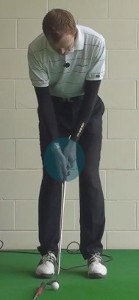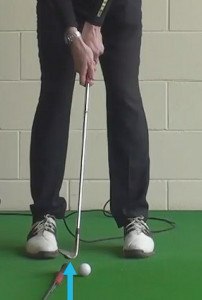
Your golf ball has come to rest on the fringe of the green, nestled against a collar of rough.
Facing one of golf’s trickiest, most delicate shots, what should you do?
Consider these options:
- Grip down on the putter and play the ball back in your stance: The first goal is to prevent the putter from snagging on the longer grass going back, so your normal stroke won’t work. This method will shorten the putter and put your hands well ahead of the head, creating a steeper stroke. The ball may come off with topspin and roll farther than expected, so adjust accordingly

- Turn your putter on its toe and hit the ball with the end of the club: This trick is a bit riskier, so practice before using it on the course. Addressing the ball off the toe sticks the club’s heel off the ground at an angle that keeps it above the rough. Making direct contact with the club’s tip is essential; otherwise, the ball can scoot wildly off line.
- Try the “bellied sand wedge”: The technique favored by most pros also requires practice, but it’s effective. Using your putting grip and stance, choke down on the sand wedge so that its leading edge is level with the ball’s equator. Make your putting stroke, striking the ball halfway up.
- Use a Hybrid chipper: These chippers help improve your short game by taking the fear out of chipping around the green.

Traditional, Mid-Length/Belly & Long Putters
When your ball is against the collar of the green, meaning it is resting up against the fringe or collar of the grass, it can present a challenging situation for a clean putt. Here are three tricks you can try to help navigate this situation:
- Putter Face Alignment: One of the common challenges when putting from the collar is getting the putter face square at impact due to the grass interfering with the clubhead. To overcome this, you can use a hybrid or fairway wood instead of a putter. These clubs have a smaller profile and can help you get the clubface square to the target line more easily.
- Stroke Adjustment: With the ball against the collar, the grass can affect the roll and speed of the ball. To counteract this, you can make a slight adjustment to your putting stroke. Instead of a traditional pendulum stroke, try using a slightly firmer stroke with a more downward angle of attack. This helps to pop the ball up and over the collar and get it rolling more smoothly on the green.
- Lofted Club Bump-and-Run: If the collar is thicker or the grass is longer, you might consider using a lofted club, such as a 7-iron or pitching wedge, to execute a bump-and-run shot. Address the ball with the clubface slightly open, and make a firm, downward strike on the back of the ball, allowing it to pop up and roll towards the hole like a putt. This technique can be effective when there is limited green to work with or if the collar is too thick for a clean putt.
Remember, practice is essential to develop proficiency with these techniques. Spend time on the practice green experimenting with different club choices and stroke adjustments to see what works best for you. Additionally, consider the specific conditions of the collar and green you are playing on, as different grass types and course setups can influence the effectiveness of these tricks.
If you have access to a golf instructor or coach, they can provide personalized guidance and help you refine these techniques based on your skill level and the specific challenges you face on the course.






